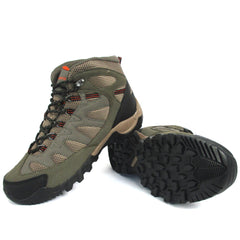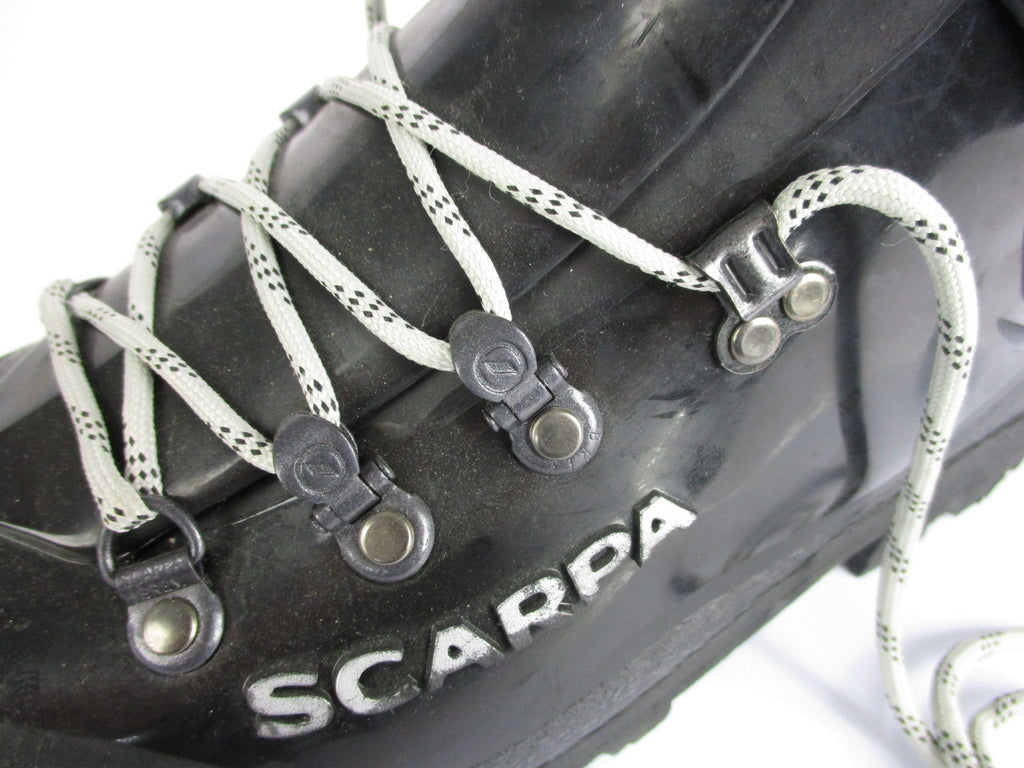Modern boots are complex systems. They aren’t just a wad of leather you strap onto your feet. Well, some of them are, but you should avoid those. A decent pair of boots has a lot of features. They can vary a lot, but let’s discuss the fundamentals, from the ground up.
The sole
Soles protect the bottom of your foot, and give you traction in terrain that’s steep, loose, wet, or a combination of the above.
Some niche companies still make boots with leather soles. These are generally a comfort or fashion choice, as leather isn’t as hard-wearing as good rubber, and it also gets pretty slippery in the wet.

Hobnailed leather soles or steel cleats have been replaced by rubber lug soles. These chunky rubber soles have deep indentations, of varying shapes and sizes. Hard rubber will last longer, and protect you if you stand on a sharp rock, stick or nail. Softer rubber can give you better grip on wet rocks.
Stiffer rubber will also give you some support; hiking boot soles aren’t designed to flex too much. This will save your leg muscles and make it easier to cross rough terrain. In saying that, on certain terrains it can be good to have a slightly more flexible sole.
The soles will be bound to the boots by a softer rubber or glue. It’s important that this is good quality because a common boot fault is that the soles peel away from the boot, especially after being stored in damp conditions or left in the sun.
Exterior
The main part of the boot can be made of many different materials, and which you choose is largely up to personal choice based on the expected environmental conditions.
Leather is a classic. It’s hard-wearing and waterproof. It will last a long time, but needs a bit of care. Genuine suede is brushed leather. It looks good, but requires even more care than regular leather.
Rubber and plastic boots are becoming more and more common. They’re easy to look after and will last a long time if they’re made of quality material. The downside here is they tend to be less breathable than organic materials.

Canvas boots provide more support than sneakers, and are lighter than leather boots. Their main advantage is 'breathibility', essential in humid climates - jungle boots are a good example.
Cordura is a brand of fabric consisting of a heavy duty nylon mesh. This material is known for its durability and resistance to wear.
Whichever material you choose, make sure it is quality stuff so your boots will be with you a long time. The body of the boot must be selected for the activity that you will use it for, and the shape of your foot. You need to find a boot that is comfortable, provides enough ankle support, and is lightweight enough for you to handle.
The Tongue
Boot tongues (the floppy bit under the laces) are much the same, one of their main goals is to keep debris out. The one thing to check is that it’s sealed against water if you’re going to be in a wet environment.
Interior
They key with boots interiors is to find something that is comfortable, insulating and breathable. Other features – such as water-wicking technology – are extras that you may or may not find important.
Inner soles are generally made of rubber with a fabric surface. If the inner sole in the boot you want doesn’t perfectly fit the arch of your foot, don’t panic. You can buy a replacement inner sole at just about any footwear shop for not very much money.

Gore-tex is lightweight and breathable, so generally considered a good option, though it can be pricey. Many outdoor manufacturing companies offer their own variation of a waterproof membrane, such as Hi-Tec's Dri-Tec® fabric.
Fastening Systems
Laces & Eyelets
The most common fastening system is the lace system. The eyelets that the laces go through are another thing that regularly breaks on boots, these can also include loops and hooks. The lower eyelets are usually made of steel, and come in several different designs. No one design is objectively superior, but they should be connected to the boot in a sturdy manner – such as with a rivet – and they shouldn’t easily flex.
Upper eyelets are sometimes made of fabric. This is fine as long as they are good quality material. One advantage of fabric eyelets is that they are easy to repair in the event they do break.
Boot laces break all the time. They have a hard life: constantly being tensioned through steel eyelets, dragged through the mud, getting wet, drying out, getting wet again, and snagging on thorns.

Traditionally laces were made of organic materials such as leather, cotton, or hemp. You can still find leather ones if you really look, but there’s no real advantage. Other organic materials are grippy and stay tied up better, but don’t last as long as synthetic laces. Fully synthetic laces are more slippery and can come undone. Most modern boot laces are a combination of synthetic and organic materials.
The hard bits on the end of the laces are called aglets. These make it easier to thread laces through boot eyelets, and they stop the laces fraying. They can be made of metal or plastic. There isn’t any real advantage either way: metal ones can sometimes bend and fall off, and plastic ones can wear out. If the worst comes to the worst and they don’t last, you can wrap some sellotape around the end of your lace.
At the end of the day, there isn’t much to choose between different brands of laces. Get a pair that is the right length for your boot, a 9 to10 hole pair of boots would need a 200cm long pair of laces, don’t buy the really cheap ones (even the expensive ones are cheap), and take a spare pair. For the survivalist minded, get some 550 paracord and make you own laces.
Zippers, Straps, Belts and Buckles
 Zips are fast and easy to do-up and undo, as are buckles. There are also combinations of all of these - including laces. Though convenient, buckles and zips are added points of failure on a boot. It just depends if you think the risk is worth the reward. Always make sure any zips are high quality, YKK branded zips, for example, shouldn't give you any problems for a long time.
Zips are fast and easy to do-up and undo, as are buckles. There are also combinations of all of these - including laces. Though convenient, buckles and zips are added points of failure on a boot. It just depends if you think the risk is worth the reward. Always make sure any zips are high quality, YKK branded zips, for example, shouldn't give you any problems for a long time.





2 comments
Anonymous
Hi Jack,
We have got ponchos. Please search on the website or visit https://www.armyandoutdoors.com/collections/ponchos
Also, we have boot polishing kit, Please visit https://www.armyandoutdoors.com/collections/boot-brushes-kits
Regards,
Army and Outdoors
Dr Jack Dascalu
Do you have any army ponchos for rain? Also any boot polishing kits? Thanks